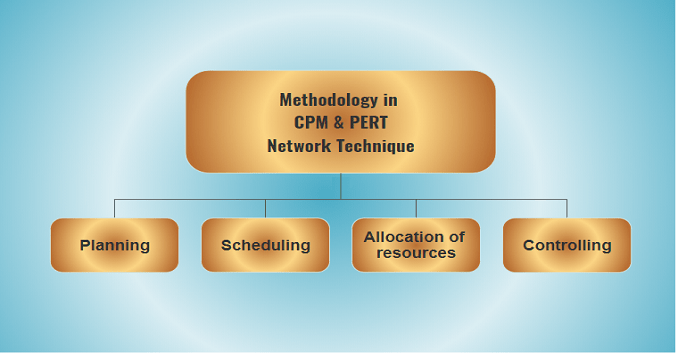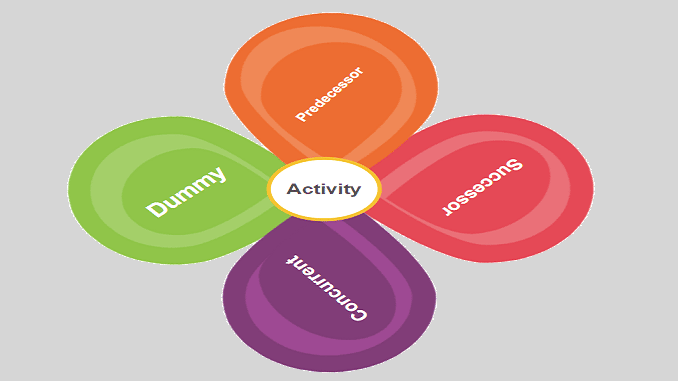
Methodology in PERT and CPM Techniques / 4 Basic Steps in Network (PERT & CPM) Techniques / Stages in Application PERT:
The network scheduling methodology used by PERT and CPM techniques for any project consists of four stages as follows:
Step-1: Planning –
Planning begins by breaking down the overall project into smaller projects.
Smaller projects are further subdivided into different activities, and then a department or section analyzes these activities.
Each activity’s relationship to other activities is defined and established.
Step-2: Scheduling-
The purpose of scheduling is to provide the earliest and latest acceptable start and finish times for each activity, as well as its relationship to other activities in the project.
The critical path, or time activities that require special attention if the project is to be completed on time, must be identified in the schedule.
Step-3: Allocation of resources-
The goal of resource allocation is to accomplish the desired objective.
Physical variables such as labour, cash, space, or equipment are resources, that impose a limitation on a project’s completion.
Step-4: Controlling-
Controlling is the final phase in project management.
Following the creation of a network plan and the identification of the critical path, the project is controlled by comparing progress to the schedule, assigning and scheduling manpower and equipment, and analyzing the effects of delays.
This is accomplished by issuing progress reports from time to time and continuously updating the network.
Periodic progress reports are created using arrow diagrams and time charts.
Read Also: Difference between PERT and CPM
PERT & CPM Methodology in Hindi:
किसी भी परियोजना के लिए CPM/PERT द्वारा उपयोग की जाने वाली नेटवर्क शेड्यूलिंग पद्धति में निम्नानुसार चार चरण होते हैं:
Step-1: योजना (Planning) –
योजना प्रक्रिया समस्त परियोजना को छोटी परियोजनाओं में विभाजित करने के साथ शुरू होती है।
छोटी परियोजनाओं को आगे विभिन्न गतिविधियों में विभाजित किया जाता है, और फिर एक विभाग या अनुभाग या इकाई इन गतिविधियों का विश्लेषण करता है।
प्रत्येक गतिविधि का अन्य गतिविधियों से संबंध परिभाषित और स्थापित होता है।
Step-2: ख़ाका खींचना या अनुसूची (Scheduling)-
शेड्यूलिंग का उद्देश्य प्रत्येक गतिविधि के लिए जल्द से जल्द और नवीनतम स्वीकार्य प्रारंभ और समाप्ति समय प्रदान करना है, साथ ही परियोजना में अन्य गतिविधियों के साथ इसका संबंध है।
यदि परियोजना को समय पर पूरा करना है तो महत्वपूर्ण पथ, या समय की गतिविधियाँ जिन पर विशेष ध्यान देने की आवश्यकता है, उनका अनुसूची में विशेष रूप से उल्लेख करना चाहिए।
Step-3: संसाधनों का आवंटन (Allocation of resources) –
संसाधन आवंटन का लक्ष्य वांछित उद्देश्य को पूरा करना है।
भौतिक चर जैसे श्रम, मुद्रा, स्थान या उपकरण आदि संसाधनों के उदाहरण हैं जो एक परियोजना के क्रियान्वन (पूरा होने) को सीमित करता है।
Step-4: नियंत्रण (Controlling) –
परियोजना प्रबंधन का अंतिम चरण नियंत्रण है।
एक नेटवर्क योजना के निर्माण और महत्वपूर्ण पथ की पहचान करने के बाद, परियोजना को, समय-सारणी में प्रगति की तुलना करके, मानव शक्ति (श्रम) और उपकरणों को आवंटित (असाइन करने) और शेड्यूल करने और देरी के प्रभावों का विश्लेषण करके, नियंत्रित किया जाता है।
यह समय-समय पर प्रगति रिपोर्ट जारी करके और नेटवर्क को लगातार अपडेट करके पूरा किया जाता है।
समय-समय पर प्रगति रिपोर्ट (आवधिक प्रगति रिपोर्ट) बनाने के लिए तीर आरेख और समय चार्ट का उपयोग किया जाता है।
(Source – Various books of college library)
Copyrighted Material © 2019 - 2024 Prinsli.com - All rights reserved
All content on this website is copyrighted. It is prohibited to copy, publish or distribute the content and images of this website through any website, book, newspaper, software, videos, YouTube Channel or any other medium without written permission. You are not authorized to alter, obscure or remove any proprietary information, copyright or logo from this Website in any way. If any of these rules are violated, it will be strongly protested and legal action will be taken.





Be the first to comment